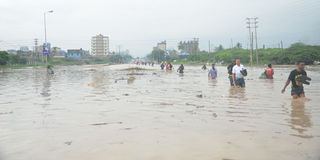Prime
Tanzanians count losses as El Nino rains wreak havoc

What you need to know:
- Data shared on November 13, 2023, by the local government with TRCS shows that while 1,245 houses were completely destroyed, 1,074 latrines collapsed.
Dar es Salaam. Prevalent El Nino-induced rains have caused flooding and landslides that have affected about 10,090 individuals, or 2,018 households, and killed 12 Tanzanians, according to the Tanzania Red Cross Society (TRCS).
Data shared on November 13, 2023, by the local government with TRCS shows that while 1,245 houses were completely destroyed, 1,074 latrines collapsed.
“The afflicted areas’ residents have been evacuated and relocated to previously designated safer areas. They cannot, however, get essential services as easily,” reads part of the TRCS situation report themed: Health Protection and Human Rights Shelter and Non-Food Items Water Sanitation Hygiene.
The TRCS document submitted to the International Federation of Red Cross and Red Crescent Societies (IFRCRCS) for the mobilisation of relief funds shows that floods have washed away crops.
The majority of the displaced populations are farmers, businessmen, and pastoralists.
“This has put the livelihoods of these communities in jeopardy. Floods have wreaked havoc on local infrastructure, livelihoods, and personal property, destroying schools, roads, and bridges as well as 2,202 acres of farmland,” reads part of the document.
“The areas affected are prone to waterborne and communicable diseases and due to contaminated water sources and limited access to basic services for evacuees, there is an increased risk of a waterborne disease outbreak.”
TRCS acting director for disaster management, Alfred Mwanjali, told The Citizen yesterday that the IFRC has approved 90,984 Swiss Francs, which is equal to Sh258 million for the Disaster Response Emergency Fund (DREF). He said the money would be used for conducting detailed assessment across affected regions that would be subjected to an operational DREF and support response initiative that has already been started by local government through the contingency plan.
‘The Red Cross plans to also continue providing humanitarian assistance to all affected people,” he said.
Yesterday, the Tanzania National Roads Agency’s (Tanroad) chief executive officer, Mr Mohamed Besta, said the downpour has severely destroyed infrastructure in Dar es Salaam, Arusha, Tanga, Kilimanjaro, Mbeya, and Songwe regions.
He was presenting a report to the Minister of Works, Innocent Bashungwa, in Tanga Region, saying the infrastructure at the country’s business hub, Dar es Salaam, has been severely affected as roads and key bridges, especially along the Msimbazi River, have been destroyed.
Mr Besta said in Tanga that the downpour has mostly affected Mokocheni Village as well as Bwiko Bridge.
“Morogoro Region is not on the list of severely affected areas because, after the Tanzania Meteorological Authority (TMA) forecasts, a team of experts was deployed. However, no damage has been recorded,” said Mr Besta.
The Tanroad boss said the agency, along with other government agencies, has started repairing destroyed infrastructure in order to restore it to its original condition.
During the event, Mr Bashungwa directed Tanroads to ensure payment to contractors involved in emergency flood response work was accelerated, emphasising that delays in payments wouldn’t be tolerated.
The government recently launched the National El Niño Contingency Plan and Anticipatory Action for Tanzania Mainland in response to a TMA warning about rains forecast to hit the country between October and December 2023.
Yesterday, a senior official at the Prime Minister’s Office (PMO) responsible for disaster management said on anonymity that the Minister of State responsible for Policy, Parliament, and Coordination, Jenista Mhagama, was now touring affected areas to inspect the magnitude of the disasters.
“Being the spokesperson on issues of disaster management, she will be in a position to provide details after the inspection,” she said.





